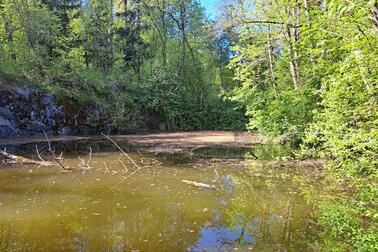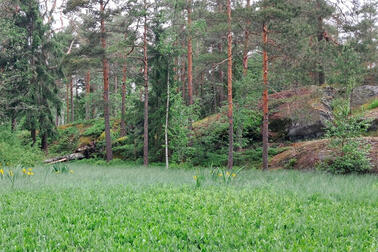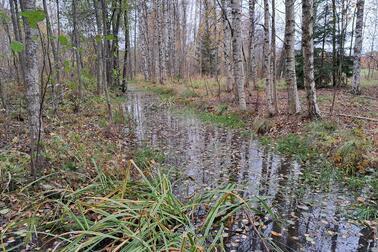
This year, the City of Helsinki is preparing to establish three new nature reserves in the vicinity of Mustavuori, north of Vuosaari. Nature reserves are also planned for southern Vuosaari and Tali in western Helsinki.
Helsinki establishes at least five new nature reserves every year to protect biodiversity. This goal is outlined in the Helsinki City Strategy for 2021–2025. The areas under preparation for nature reserves are based on the Helsinki Nature Conservation Programme (2015–2024).
This year, the nature conservation areas being prepared are called the Mellunmäki flood meadow, the Meri-Rastila nature reserve, the southern part of Mustavuori, the southern shore of Porvarinlahti and the Tali nature reserve.
In 2023, the total area of nature reserves in Helsinki was around 1,424 hectares, with one-third consisting of water bodies. The combined area of the areas under preparation now is around 129 hectares.
The intention is for all planned nature reserves to remain open for recreational use.
The nature reserves to be established in 2024:
Mellunmäki flood meadow
Located between the Mustavuori nature reserve and Kallvikintie on the border of Mellunkylä and Vuosaari. The area is around 7 hectares.
Terrain: The northern half of the area is an open flood meadow, consisting mainly of dense meadows. The wetter areas feature patches of genuine wetland dominated by water sedge and bottle sedge or marsh cinquefoil and common cottongrass.
Vegetation: Species vulnerable in Helsinki such as the pygmy smartweed and three-petal bedstraw have been observed in the area, as well as the Arctic bramble, near-threatened in Helsinki.
Animals: Various shrubland birds and nocturnal singers are well represented in the flood meadow area. In several years, the area has hosted a territory of the corncrake or the spotted crake, which occurs in very small numbers.
Meri-Rastila nature reserve
Located in Vuosaari, on the shore of the Vartiokylänlahti bay within an extensive forested area. The area is around 35 hectares.
Terrain: The forest in Meri-Rastila is mainly near-natural mesic and herb-rich heath forest and rocky forest. There are a few bog hollows between the rocks. The south-western part of the forest area includes three stone fields. The most prominent of these, the Meri-Rastila stone field, formed 7,000 to 8,000 years ago when waves smoothed the stones brought by the ice into rounded shapes and washed them ashore.
Vegetation: The area’s northern marsh supports species such as the round-leaved sundew, which is vulnerable in Helsinki. Regionally endangered species such as Carex loliacea and the softleaf sedge grow in the Ramsinkannas herb-rich forest.
Animals: The western part of the area belongs to the important bat area of Vartiokylänlahti, and the forest east of Vartiokylänlahti is valuable for birdlife: it has been home to species such as the red-breasted flycatcher and the greenish warbler.
The southern part of Mustavuori
Located in Vuosaari, south of the Mustavuori-Porvarinlahti nature reserve. The area is around 29 hectares.
Terrain: The area consists primarily of rocky forest terrain as well as reed-covered bays and shoreline forests belonging to the Natura 2000 area. The eastern part features fine old pastureland. There are two springs in the area.
Vegetation: The western part of the area features a cliff with species such as the near-threatened stoloniferous pussytoes and the lesser butterfly-orchid, which is endangered in Helsinki. Near the power line, there are species like the moonwort, the pyramidal bugle and the alpine cinquefoil, which is endangered in Helsinki. The old limestone quarries host mosses that prefer lime-rich environments.
Animals: The breeding birds include the hazel grouse, nightjar and red-breasted flycatcher, all rare in Helsinki. The southern part of Mustavuori is an important habitat for reptiles and amphibians. The forests in the eastern part are valuable bat habitats.
The southern shore of Porvarinlahti
Located north of Vuosaari Harbour on both sides of the Porvarinlahti bay. The area is around 42 hectares.
Terrain: The area consists mainly of forested terrain, shoreline meadows and the reed-covered waters of Porvarinlahti. The water area belongs to the bird waters of the Mustavuori herb-rich forest and Östersundom, which are part of the Natura 2000 area.
Vegetation: The area features coastal meadows and flood meadows, as well as cliffs and the herb-rich forests and eutrophic spruce mires between them. The vegetation is diverse, with several endangered or near-threatened species found in Helsinki.
Animals: Porvarinlahti is home to various species of reed-dwelling birds. The breeding birds also include the vulnerable great reed warbler, the common tern, which is listed in the Birds Directive, and the declining waterbird coot. Porvarinlahti is an important habitat for amphibians and reptiles.
Tali nature reserve
Located in Pitäjänmäki near the Tali manor park and the golf course. The area is about 16 hectares.
Terrain: The area includes a herb-rich forest surrounding the Mätäjoki river and associated flood meadows.
Vegetation: The western part of the area features an extensive area of abundant grassy flood meadows. Alongside the yellow iris, representative grasses include exceptionally abundant waterhorehound as well as cowbane and marsh pea.
Animals: Due to the abundance of deadwood, many woodpeckers thrive in the area, including the rare lesser spotted woodpecker and the endangered white-backed woodpecker. Other characteristic bird species in the area include the Blyth’s reed warbler, marsh warbler, river warbler and Icterine warbler. The area is also good hunting grounds for bats, and the rare Nathusius’ pipistrelle has been observed there.


